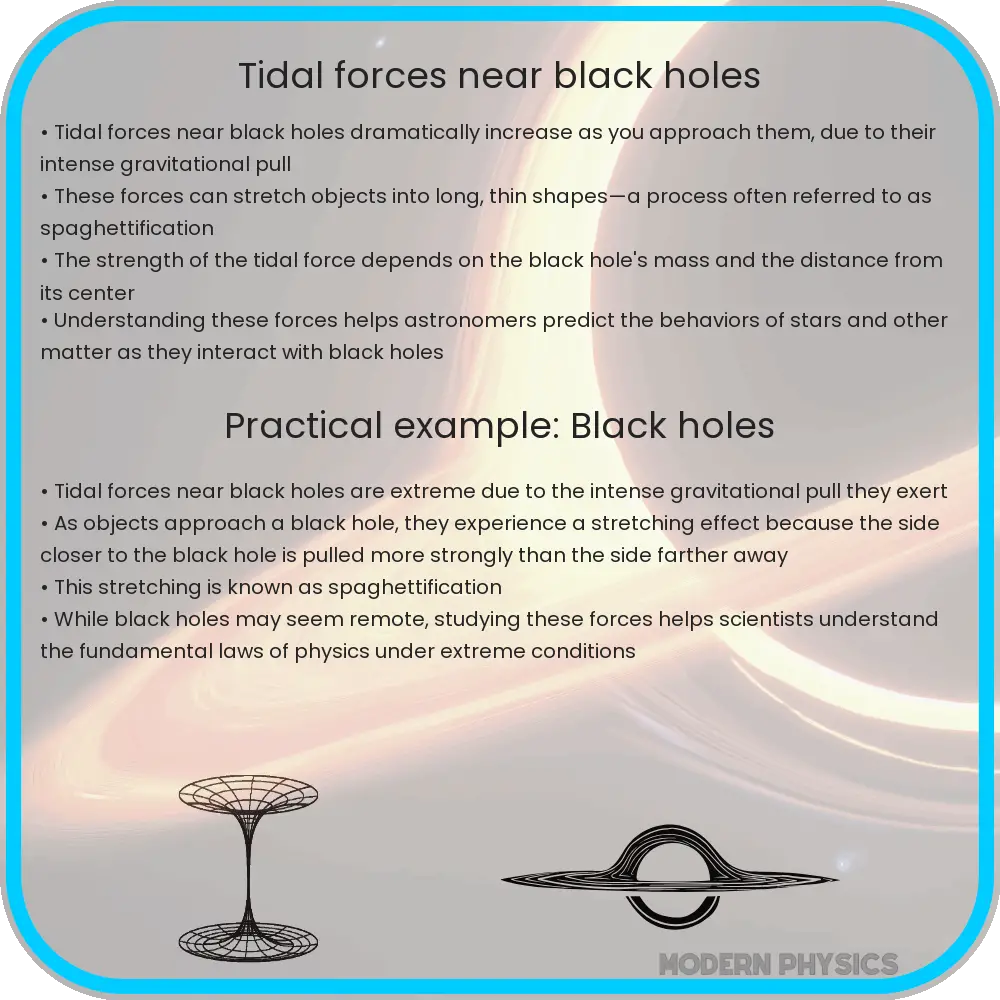Explore the mysteries of black holes and tidal forces, uncovering spaghettification, Hawking Radiation, and space-time in this insightful article.

Understanding Tidal Forces Near Black Holes
The concept of tidal forces near black holes is a fascinating and complex aspect of astrophysics, deeply rooted in the theories of relativity, gravity, and space-time. These forces are not only essential in understanding black holes but also provide insights into the fundamental laws of the universe.
The Nature of Black Holes
Black holes, the enigmatic cosmic phenomena, are regions of space where gravity is so strong that nothing, not even light, can escape from it. This immense gravitational pull is due to the mass of the black hole being concentrated into an incredibly small area. This creates a singularity at the center, surrounded by an event horizon, the point beyond which nothing can return.
Relativity and Space-Time
The theory of General Relativity, proposed by Albert Einstein, plays a crucial role in understanding black holes. According to this theory, mass warps space-time, and this curvature is what we perceive as gravity. Near a black hole, this warping becomes extremely severe, leading to some unique and intriguing phenomena.
Tidal Forces Explained
Tidal forces are differences in gravitational pull experienced by an object over its length. In the context of black holes, these forces become significantly pronounced. As an object approaches a black hole, the part of the object closer to the black hole experiences a stronger gravitational pull than the part further away. This difference can stretch the object, an effect known as spaghettification.
Gravitational Time Dilation
Near a black hole, the intense gravity also causes a phenomenon known as gravitational time dilation. According to General Relativity, time runs slower in stronger gravitational fields. This means that time near a black hole passes slower compared to areas with weaker gravitational fields.
Impact on Space Missions
Understanding tidal forces near black holes is crucial for future space missions and the study of the universe. It helps in predicting the paths of spacecraft and celestial bodies around these massive objects. Moreover, it provides a window into studying the extreme conditions of the universe where the known laws of physics are pushed to their limits.
The study of tidal forces near black holes is not just academic; it has practical implications in the field of astrophysics and space exploration. As we delve deeper into the cosmos, understanding these forces becomes increasingly essential in unraveling the mysteries of the universe.
Spaghettification and the Event Horizon
A key phenomenon associated with tidal forces near black holes is spaghettification. As an object gets closer to the event horizon, the gravitational differential (the difference in gravity’s strength across an object) becomes so extreme that objects are stretched into long, thin shapes, resembling spaghetti. This effect exemplifies the immense power of black holes and the extreme nature of their gravitational influence.
Exploring Hawking Radiation
Another fascinating aspect of black holes is Hawking Radiation, theorized by physicist Stephen Hawking. This quantum mechanical process involves particle-antiparticle pairs forming near the event horizon, with one particle falling into the black hole and the other escaping. This phenomenon suggests that black holes are not entirely black but emit radiation and can potentially evaporate over astronomical timescales.
The Role of Accretion Disks
Around many black holes, accretion disks form, consisting of matter spiraling into the black hole. The intense gravitational forces heat this matter to extremely high temperatures, emitting large amounts of radiation. Studying these accretion disks provides valuable insights into the behavior of matter under extreme gravitational forces and the dynamics of black holes.
The Challenge of Observing Black Holes
Observing these phenomena directly is challenging due to the black hole’s nature. However, advancements in technology, such as the Event Horizon Telescope, have made it possible to study these cosmic giants more closely. Through indirect observation methods, scientists have been able to validate many theories about black holes and their surrounding phenomena.
Conclusion: The Significance of Tidal Forces in Astrophysics
In conclusion, tidal forces near black holes offer a profound glimpse into the behavior of matter and energy under extreme conditions. They not only validate key concepts in Einstein’s theory of General Relativity but also challenge our understanding of physics. The study of these forces, along with phenomena like spaghettification, Hawking Radiation, and accretion disks, continues to push the boundaries of astrophysics. As we improve our observational techniques and theoretical models, we edge closer to unraveling more mysteries of these fascinating cosmic objects. Ultimately, black holes are not just astronomical curiosities but are key to understanding the fundamental nature of the universe and the very fabric of space-time.
